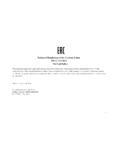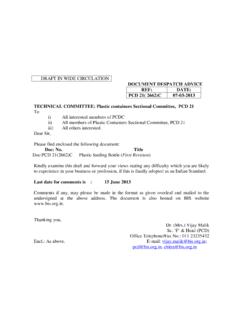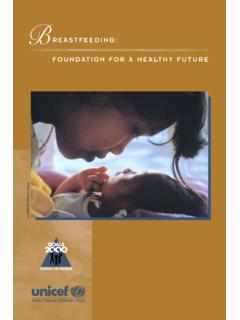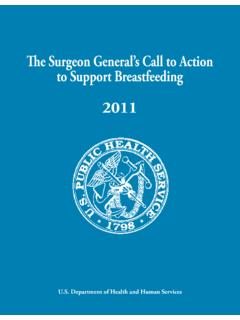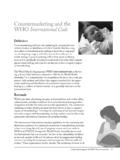Transcription of GLOBAL BREASTFEEDING SCORECARD, 2017 Tracking …
1 GLOBAL BREASTFEEDING scorecard , 2017 Tracking progress for BREASTFEEDING Policies and ProgrammesUNICEF | WORLD HEALTH ORGANIZATION | 32 | GLOBAL BREASTFEEDING scorecard , 2017 | Tracking BREASTFEEDING Policies and ProgrammesBREASTFEEDING IS ONE OF THE MOST EFFECTIVE INVESTMENTS A COUNTRY CAN MAKE TO ENSURE A SMARTER, HEALTHIER It protects children from a myriad of illnesses, increases IQ, and promotes a strong bond between mother and infant. It also plays a role in decreasing mothers risk for breast cancer and lowers healthcare costs for families and societies.
2 BREASTFEEDING has huge implications for a country s future prosperity. Unfortunately, countries are not adequately protecting, promoting, and supporting BREASTFEEDING through funding or policies. As a result, a majority of children in the world are not breastfed as recommended, missing out on the vital benefits BREASTFEEDING offers. Although every mother decides how to feed her infant, this decision is strongly influenced by economic, environmental, social, and political factors, such as inadequate healthcare support, marketing of baby foods, and workplace support to women.
3 Countries have a responsibility to improve their funding, legislation, and health programmes to support GLOBAL BREASTFEEDING scorecard documents key indicators on the policies and programmes that impact BREASTFEEDING rates and provides information on current rates of BREASTFEEDING around the world. It is intended to encourage progress , increase accountability, and document change for all countries as they take the necessary steps to protect, promote, and support DOES BREASTFEEDING MATTER?n Scaling up BREASTFEEDING could save 823,000 lives per year among children ages five years old and BREASTFEEDING reduces the risk of non- communicable diseases and decreases the prevalence of overweight and/or obesity later in life.
4 N Nearly half of all diarrhoea episodes and one-third of respiratory infections would be prevented with improved BREASTFEEDING practices in low-and middle-income countries. BACKGROUNDS trong evidence indicates that BREASTFEEDING is the best practice for child health, development and nutrition. WHO and UNICEF recommend that BREASTFEEDING be initiated within one hour of birth, that it continue with no other foods or liquids for the first six months of life, and be continued with complementary feeding ( BREASTFEEDING with other age-appropriate foods) until at least 24 months of age.
5 In recognition of this, the World Health Assembly has set a goal of increasing the rate of exclusive BREASTFEEDING to at least 50% by The GLOBAL BREASTFEEDING Collective (Collective), a partnership of non-governmental organisations, academic institutions, and donors, led by UNICEF and WHO, was formed to accelerate progress towards this goal as well as towards improving rates of BREASTFEEDING initiation and continuation for two This initiative aims to look beyond the WHA target to 2030, in alignment with the timeline of the Sustainable Development Goals, and to add explicit targets for the other critical aspects of BREASTFEEDING .
6 The Collective s Call to Action emphasizes seven priorities to improve national support for These priorities, described in the Table below, highlight the need for funding of BREASTFEEDING programmes, ending the promotion of breast-milk substitutes, protecting the rights of employed women, providing appropriate health care services, ensuring community support for BREASTFEEDING , and developing monitoring systems to track and improve programmes. scorecard INDICATORSThe Collective has identified at least one indicator for each of the seven priorities for action and has set a target to be achieved by the year 2030.
7 Indicators were selected based on their relevance to the priority and on the availability of data. For some indicators, limited data exist, particularly from high-income countries. The GLOBAL BREASTFEEDING scorecard compiles data from countries throughout the world on the current status of each of these indicators. The current status of the country is categorized into four levels. The top level, colour coded as green, indicates that a recommended level of performance has been achieved. It should be noted that many of the standards set by these indicators are minimum recommendations.
8 Therefore, even countries that have a high score for a given indicator should carefully evaluate what they can do to further improve or maintain their BREASTFEEDING practices. Lower levels of performance are graded into three levels, colour coded as yellow, orange, and red, with red indicating the lowest level of support. (Methodological notes available at BREASTFEEDING also brings benefits to women, including prevention of breast and ovarian cancer and Longer BREASTFEEDING durations are associated with higher scores on intelligence tests that translates into stronger economic success through improved academic performance, higher earning potential and Countries lose more than $300 billion annually because of low rates of BREASTFEEDING ( percent of GNI).)
9 3 PERCENT OF COUNTRIES BY AMOUNT OF FUNDING ALLOCATED TO BREASTFEEDING SUPPORT PROGRAMMES, BY REGIONWORLD ASIAAMERICASAFRICA 025%50%100%75%> $5 PER BIRTH> BETWEEN $2 AND $5 PER BIRTH> BETWEEN $1 AND $2 PER BIRTH< $1 PER BIRTHNO DONOR FUNDING UNICEF | WORLD HEALTH ORGANIZATION | 54 | GLOBAL BREASTFEEDING scorecard , 2017 | Tracking BREASTFEEDING Policies and ProgrammesCurrently, no countries score highly on all eight policy and programme indicators. In fact, only six countries were classified as achieving a recommended performance level in more than half of the plays a vital role in the creation and maintenance of programmes that support infants, mothers, and health workers.
10 For the GLOBAL BREASTFEEDING scorecard , information on donor funding that was allocated to BREASTFEEDING support in 2013 was The World Bank and Research for Development (R4D) made these estimates based on an analysis of all budget items related to nutrition, allocating expenditures to the outcomes they were intended to impact. The donor funding per country was divided by the number of newborns in the country, to allow comparison across countries. The minimum level of funding was set at US$5 per birth per year. Data regarding government expenditures on BREASTFEEDING by country have not yet been collected in a systematic Only seven countries globally receive at least US$5 per birth to support BREASTFEEDING programmes.











